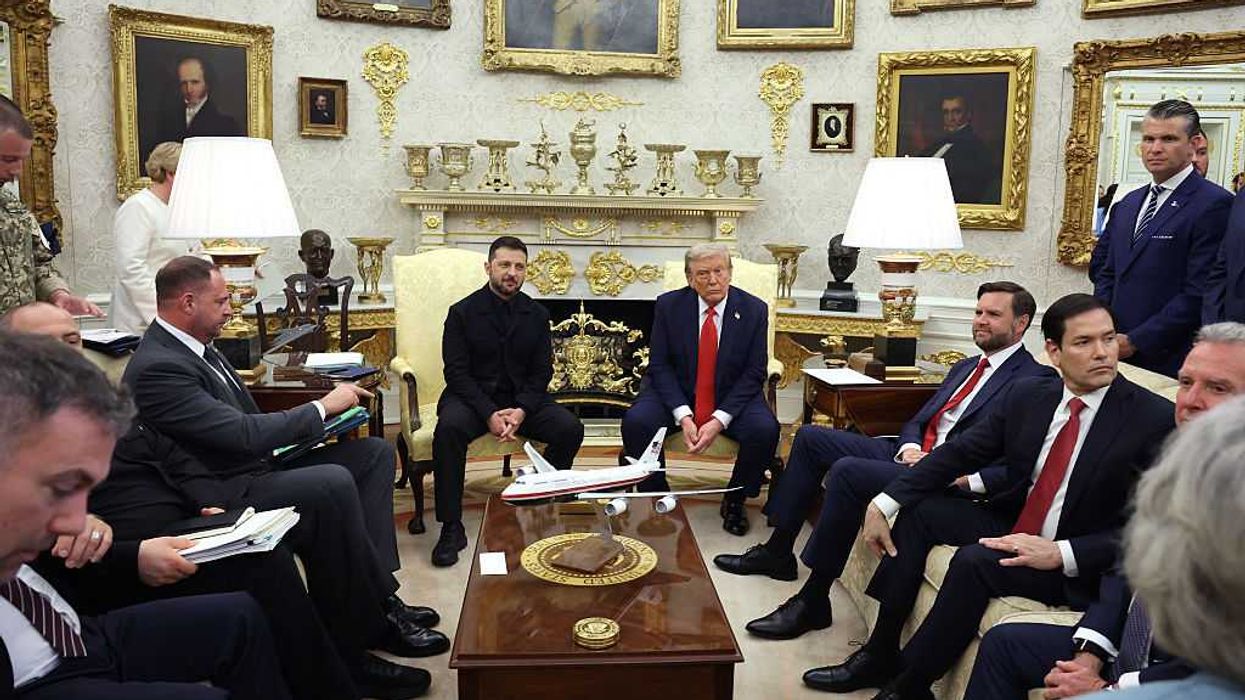Goldberg is editor-in-chief of The Dispatch and the host of The Remnant podcast. His Twitter handle is @JonahDispatch.
There's no record of Edmund Burke -- the great Irish-born British statesman and father of modern conservatism -- actually saying what is often attributed to him: "The only thing necessary for the triumph of evil is for good men to do nothing." But it does capture his worldview well enough.
It also captures a renewed, possibly short-lived triumph of courage and wisdom within the Republican Party.
Amid threats to oust House Speaker Mike Johnson for allowing a vote on aid to Ukraine, Rep. Tony Gonzales (R-Texas) captured the party's own divide between the good and the rest in colorful terms on CNN Sunday. "It's my absolute honor to be in Congress," he said, "but I serve with some real scumbags."
Gonzales was taking aim at Reps. Matt Gaetz (R-Fla.) and Bob Good (R-Va.), but he could have included quite a few others.
For the last few years, congressional Republicans have been split into factions that are not ideological in the traditional sense. Pick nearly any standard domestic policy issue -- abortion, gun rights, taxes, immigration -- and you won't see much evidence of the schism. Even (public) support for Donald Trump doesn't delineate the divide.
No, the difference is largely over tactics, rhetoric and psychology. One faction, comprising an overwhelming majority of the House GOP caucus, is interested in accomplishing the possible. The other is more interested in aiming for the impossible and then complaining about falling short.
Of course, members of the latter group don't admit to the impossibility of their goals; that would ruin the con. They insist that with enough willpower, particularly among their leaders, they could impose their will on the Democratic-controlled Senate and White House. They make that case on television, on social media and in floor speeches. And when they inevitably fail, they whine that they were "betrayed" by Republican quislings who collaborated with the Democrats, all while raising money off the notion that they're courageous warriors who are willing to lose on principle.
The success of their shtick has depended on a number of factors. One is that the Republicans' narrow House majority empowers the fringe.
To become speaker last year, Kevin McCarthy agreed to a change in the rules that makes it possible for a single representative to move to "vacate the chair" -- that is, trigger a vote on whether to depose the speaker. That's what happened last year after McCarthy avoided a default on the national debt, kept the government open and committed other alleged outrages.
Gaetz and seven other Republicans, representing less than 2 percent of the country, were enough to oust McCarthy against the wishes of 95 percent of the Republican caucus, with Democrats uniformly hewing to the bipartisan tradition of refusing to support a speaker of the opposite party. In other words, the Republican firebrands, who think the worst sin imaginable is to work with Democrats, voted with Democrats to oust their leader.
McCarthy's successor, Johnson, brought four bills to the House floor Saturday -- three to provide vital military aid to Ukraine, Israel and Taiwan, and one to force a Chinese company to sell TikTok or cease operating in the United States. The bills passed overwhelmingly, with all but the Ukraine bill winning a majority of Republicans' votes.
Now Reps. Marjorie Taylor Greene (R-Ga.), Paul Gosar (R-Ariz.), and Thomas Massie (R-Ky.) want to oust Johnson for his "betrayal" -- not of the caucus, country or Congress but of the tiny fringe faction that thinks it should call the shots.
They'll probably fail, for several reasons. First, few Republicans -- including some who oppose Johnson -- want to be seen following the lead of the House's most notorious cranks and bigots. Second, Trump doesn't want the Republican caucus to turn into an embarrassing circular firing squad while he is running for president. (It's remarkable that Trump is worried that other Republicans will make him look bad.) Third, Democrats have signaled that they will help Johnson keep his job after he courageously did the right thing. And finally, no one appears to want Johnson's job who could also get the job.
The most important development for the party in all of this is that the rest of the caucus has realized that going along with the arsonists -- all of whom have safe seats and would be happy to throw their bombs from the House minority -- amounts to politically suicidal appeasement.
"The majority of the majority -- the vast majority of the majority -- is sick and tired of these high school antics," Rep. Derrick Van Orden (R-Wis.) said last week. He also noted that "the only way to stop a bully is to push back hard."
One can only hope that realization sticks.
First posted April 24, 2024. (C)2024 Tribune Content Agency, LLC.



















